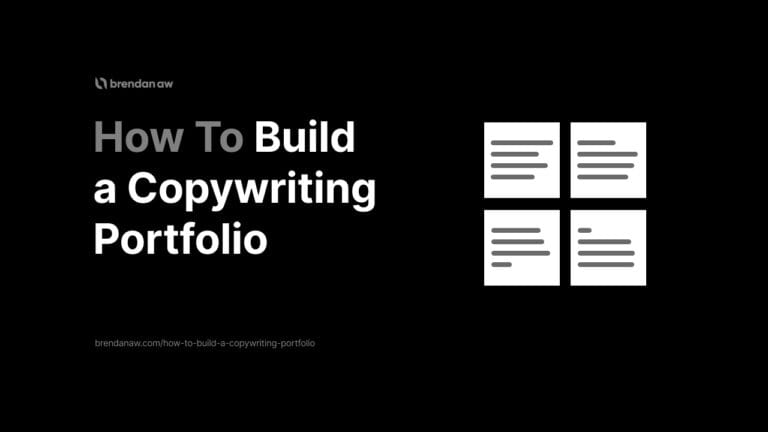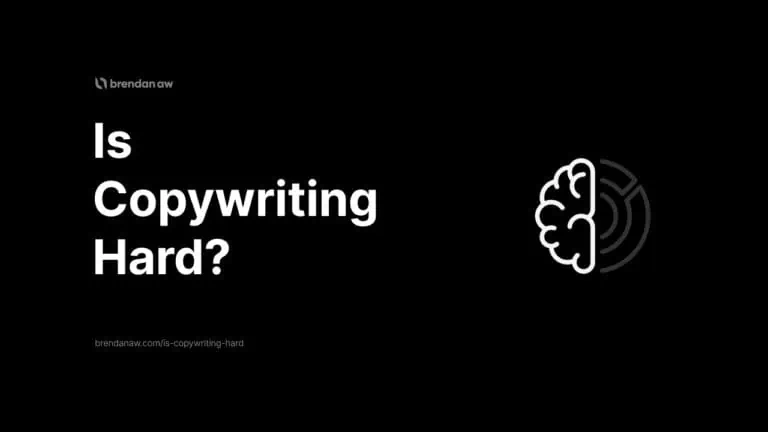There’s one thing that sets great copywriters apart.
And it’s not eloquence nor flair…
It’s knowing what people want and what they go through.
That’s the secret to making your reader go…
“Damn, this is exactly what I’m looking for!”
So how do great copywriters do it?
Research.
In this article, I’ll show you:
- What copywriting research is
- Why you shouldn’t write a word without research
- The best online resources for copywriting research
- Common research pitfalls
And that’s not all of it…
I’ll also walk you through my step-by-step copywriting research process.
Sounds good?
Let’s dive in.
What is Copywriting Research?
Copywriting research is the process of extracting relevant information to write compelling copy for a target audience.
It’s the MOST important step in the copywriting process.
Because it helps you:
- Understand your product or service thoroughly.
- Identify your audience’s pain points and desires.
- Gain insights to outperform competitors.
Copywriting is more than words.
It’s about sparking a connection with your audience.
The more thorough your research, the smoother your writing process becomes.
Why?
Because now you have the data to light that spark.
So if you want to become a copywriter, you MUST do this.
Why is Copywriting Research Important?
Copywriting research is a cornerstone of effective marketing and communication strategies.
It’s not just about crafting persuasive text; it’s about understanding the heart and soul of your audience, their needs, desires, and the specific language that resonates with them.
Here are the top reasons why copywriting research is non-negotiable:
Avoids Message-Customer Mismatch
No matter how many psychology tricks or copywriting frameworks you’ve implemented…
If there is a message-customer mismatch…
They’re not converting.
You gotta speak directly to your audience.
The only way to do that is to articulate their needs and desires.
- What problem/s are they facing?
- How would your product or service solve their problem/s?
You’ll find those answers if you’ve done good research.
Creates Timeless Copy
Trends come and go.
But some problems remain the same.
Once you have a deep understanding of your audience’s evergreen needs…
You can create copy that grips your audience for months, years, or even decades.
Think of:
- Nike’s “Just Do It.”
- Apple’s “Think Different.”
- And Disneyland’s “The Happiest Place On Earth.”
These brands have successfully established recall and long-term impact through great copy.
So if you want maximum ROI… do your research.
Speeds Up the Writing Process
Copywriting is like solving a puzzle.
And researching is finding those puzzle pieces.
It identifies:
- Key messaging points
- Unique selling propositions
- Perfect tone and style for your audience
- And more.
Once you have these pieces…
It’s just a matter of putting them together.
This clarity eliminates the guesswork.
So you can write faster and with more certainty.
Best Resources to Conduct Research Online
The highest-quality information is hard to find…
Especially if you don’t know where to start.
So let me help you out by sharing this list. Here’s where you can find relevant information for your copywriting research:
Existing Audience
Don’t guess what your audience wants…
Ask them directly.
Your existing customers are your BEST resource for crafting effective copy.
Why?
Because they give authentic opinions about what they like and dislike about a product or service.
Here are some ways to conduct research within your existing community:
- Starting polls
- Monitoring social media engagement
- Surveying your email list
- Conducting interviews
A combination of these methods will help you gather comprehensive insights and come up with effective copy.
Online Forums
People may modify their responses when they’re aware that they are being surveyed.
That’s called “response bias.”
Not every answer is a genuine representation of your audience.
“So how can I capture their unfiltered thoughts?”
Hop on online forums like Reddit and Quora.
Users of these platforms can post anonymously…
And with minimal content moderation.
They’re more likely to share their honest opinions on these freer platforms.
YouTube
Most copywriters sleep on YouTube.
Well, they shouldn’t.
YouTube comments are a treasure trove of customer anecdotes…
In your case—the more TMI, the better.
Say you’re writing a guide on creating online courses.
Here’s how to research on YouTube:
- Search “how to create an online course” and click on the top 3 results.
- Dive into the comments section.
- Compile anecdotes, suggestions, and questions about the video.
And then formulate your copy based on your findings.
Pro Tip: Do a “ctrl/command + F” and search for “?” to highlight every question on the page.
These are invaluable insights you can use to develop or market your product.
Even better if you have your own channel.
You can pin your questions in the comments.
Or simply read what viewers ask for or say about your product.
People will ALWAYS tell you what they wanna see next.
Online Marketplaces
Online marketplaces are the best resource for outshining your competitors.
It helps you identify customer needs and market gaps.
Here are a few examples of online marketplaces:
- Amazon
- Udemy
- Coursera
- And Shopify
When browsing these sites… focus on two key features:
- Product Description: Analyze how competitors communicate their value through product listings and descriptions. This analysis helps you pinpoint opportunities in your niche.
- Customer reviews: Customer reviews on these marketplaces provide a clear snapshot of the best and worst attributes of the product. This valuable information can shape your copy effectively.
Note: Not all online reviews are authentic. It’s best to do some more digging if you find spammy reviews that seem too good to be true.
Meta (Facebook) Ad Library
The Meta Ad Library is a goldmine for competitor research.
It allows you to see the ads your competitors are running.
Every brand with Facebook or Instagram ads maintains a library of their current and past campaigns.
Studying those will save you time in A/B testing.
Because you’ll gain insights as to:
- What types of copy work (running ads)
- And what types of copy don’t (inactive ads)
Pro Tip: An ad airing for more than 6 months is a strong indicator that the copy performs well.
AnswerThePublic
I use AnswerThePublic to know what people search for concerning my topic.
And it’s my go-to resource for untapped content ideas.
It’s a supercharged Google “People also ask.”
The results are broken down into five different sections:
- Questions
- Prepositions
- Comparisons
- Alphabetical
- And related
Note: The free version allows only three searches per day.
Make each research session count.
Authority Sites
Referencing authority sites in your copywriting niche is a great way to boost your copy’s credibility.
These sources provide up-to-date stats and relevant case studies…
So I link these articles whenever I need to back up my points.
Pro Tip: Bookmark these resources for future use. You’ll never know when these sources come in handy.
But here’s the thing…
Not all content on reputable sites is equal.
So do some fact-checking and look for the most recent articles.
Here’s a rule that I follow. If an article:
- Was published 2 years ago… That’s a red flag.
- Was published 3+ years ago… It’ll never have a place on my site.
Look for articles published months up to a year ago.
How to Do Copywriting Research?
We’ve established that research is the foundation of an excellent copy.
But it’s also the root cause of ineffective copy.
Not only is it important to conduct research…
Doing it correctly is just as crucial.
So here’s my step-by-step process for writing laser-focused copy.
- Know the Product Inside Out
- Develop a Customer Avatar
- Ask Your Audience
- Use Google Search
- Join Online Forums
- Browse Online Marketplaces
- Analyze Your Results
1. Know the Product Inside Out
Whether you’re crafting copy for your own brand or another business…
In-depth product knowledge is a must.
Here’s what you need to grasp:
- Facts and Features: What are the product’s specifications and attributes?
- Benefits: How does the product address the needs and desires of the target audience?
- USPs (Unique Selling Proposition): What sets the product apart from competitors? What makes it unique or superior in the market?
How can you sell something you know nothing about?
2. Develop a Customer Avatar
Creating a customer avatar is KEY to writing targeted copy.
A customer avatar represents your ideal customer and guides your messaging.
“So how can I create a customer avatar?”
Create a table to gather the following information:
- Age
- Gender
- Income
- Location
- Social media usage
- Stage of awareness
This will give you background information on your target customer.
But why stop there?
To truly connect with your audience… You need to know why they need your offer.
If you’re writing copy for a product that solves a problem you once had…
Reflect on your own experiences:
- What problems did you encounter?
- How did you think back then?
- How did you go about solving it?
- What were your frustrations as you were solving the problem?
Here’s an example:
Say you’re writing about an e-book on growing a YouTube channel.
Consider your own journey:
- Did you wonder why your hard work wasn’t translating into views and subscribers?
- Have you experimented with different video formats, SEO techniques, and social media promotion?
- Did you find balancing content creation with other aspects of your life challenging?
This introspective examination will help you understand the current mindset of your target market.
But what if you’re writing for a different product?
Something you haven’t done before…
I got you.
Here’s the 4 Forces framework to read your customer’s minds.
- Wants: Their current desires and requirements.
- Pain: Ongoing issues and challenges.
- Goals: Their future aspirations.
- Fears: Concerns about potential future problems.
The table is structured this way on purpose.
It’ll help you collect customer anecdotes and categorize them accordingly.
Wants is the opposite of Pain.
The same goes for Goals and Fears.
For example:
A customer said, “I am struggling to monetize my blog.”
That’s a current problem…
It falls into the Pain category.
Flip it and you’ll get the customer’s Wants…
“I want to make money from my blog.”
Let’s try another one:
“I don’t want to waste time and money on my blog without making it successful.”
That’s a future problem so it falls under Fears.
Get the opposite and you’ll know their Goals…
“I want an ROI from my blog.”
3. Ask Your Audience
Now you know what you’re looking for…
Time to go to the field and find them.
The best way to know what the market wants…
Is by letting the market tell you.
If you or your client have an existing and highly engaged audience… utilize it.
I shared engagement techniques in the past section. Now, here’s how to implement them:
- Polls: Create polls to collect quick and targeted feedback on specific topics.
- Social media post: Ask an opinionated question on a post to encourage readers to give their thoughts.
- Email Surveys: Include a survey or ask a question at the end of your email newsletters to engage your subscribers.
- Interviews: Conduct one-on-one or group interviews to dive deeper into their thoughts and experiences.
These methods will:
- Help you refine your customer avatar
- Provide valuable anecdotes to connect with your audience
In my opinion…
You can get 95% of the information you need from a highly interested and engaged community.
The other 5% is just seeing what your competitors are doing.
More on that later.
Note: Not everyone has a sizable community to tap into. So if that’s you, proceed with the next step.
4. Use Google Search
Everybody searches on Google.
But not everybody browses it the right way.
Instead of vague searches like “online course creation…”
Use specific phrase match parameters.
Enclose your query in quotation marks.
- Vague search: online course creation
- Phrase match: “online course creation”
This instructs Google to display results containing the exact phrase or slight variations.
Hence, it’s narrowing down your research.
Here are a couple more search techniques to make your research more efficient:
- Site Search: Limit results to a specific website by adding “site:” before the site’s URL. (e.g.: “site:reddit.com online course.”)
- Filetype: Specify a document type using “filetype:”(e.g.: “course statistics filetype:pdf.”)
Use these tips to gather precise and relevant information efficiently.
5. Join Online Forums
The most reliable sources of information are often indirect ones.
“What you mean, Brendan?”
People may filter their responses when they know they’re the subject of a study.
They’d say what would sound right.
Not their real thoughts.
You HAVE to gather data from sources where people can freely express their thoughts.
Minimal content moderation…
Anonymity…
No response bias.
Online forums are the best resources for authentic information.
Depending on your target market… you can go to:
- Quora
- Facebook groups
- YouTube comments
- Twitter threads
- And more
Here’s how to extract raw insights:
- Find forums: Look for forums related to your topic that allow you to search without joining.
- Browse discussions: Explore these forums to discover what interests people in your niche.
- Take note: Collect relevant comments, posts, and direct quotes from these discussions.
- Organize data: Copy and paste the raw data word-for-word and sort it into your 4 Forces framework.
6. Browse Online Marketplaces
People feel safe and entitled to give their word on a product they bought.
Because they spent their hard-earned money on it.
So utilize these reviews to get unbiased opinions.
Choose the Right Marketplace
Start by selecting the most relevant marketplace for your offer.
Here are some examples:
- E-books: Amazon Kindle Direct Publishing (KDP)
- Online courses: Udemy and SkillShare
- Apps: App Sumo, Apple App Store, Google Play Store
- Digital marketing services: Fiverr and Upwork
- Printables and Templates: Etsy
- WordPress Plugins: Envato and CodeCanyon
Search and Explore
- Enter your product or offer into the marketplace’s search bar.
- Examine the top three search results.
- Pay close attention to their offer and product descriptions.
Review Customer Feedback
- Scroll through customer ratings and comments.
- Note down these insights word-for-word.
Pro Tip: Filter reviews to see 3-star ratings. This tends to be the sweet spot because people write what they like and dislike about the product.
7. Analyze Your Results
Time to reap the benefits of your labor…
Look at your data and interpret the results.
Determine your customers’ pain points and the language they use to describe them.
Here are a few questions to consider:
- Are there patterns in the customer feedback?
- What specific features of the product do customers mention?
- What language do customers use to describe their experiences?
Ask these questions to analyze customer reviews.
Then use these insights to write your copy.
What To Avoid When Doing Research for Copywriting?
Understanding what to do is essential…
But knowing what to avoid can save you time and resources during your research.
Here are some copywriting research no-nos:
Skipping Fact-Checking
Readers are quick to point out statistics that are:
- Outdated
- Misleading
- Or outright false
So if cited to any of these pages… your credibility is on the line.
Confirm the legitimacy of your sources.
And ensure that every statistic is accurate and up-to-date.
Doing Too Much Research
Information overload will lead to analysis paralysis.
Hence, you MUST define what you’re looking for before you do your research.
“So how can you tell if you’re doing too much?”
If you’re delving into topics that are no longer relevant to your target audience…
You’re probably overdoing it.
Set clear boundaries and goals before starting your research.
Not Doing Enough Research
While it may contradict the previous point…
Conducting too little research is a common copywriting pitfall.
Write a copy with insufficient info and you’ll end up with an ineffective copy.
Ensure you have these three essentials before writing:
- Product information
- Customer insights
- Competitor analysis
Researching Without a Target Customer
Researching without a customer in mind is like fishing without bait.
You might spend time and resources…
But if you don’t know what your audience is looking for…
Don’t expect they’ll come to you.
It’s also a surefire way to write brand-centric copy.
Without a customer in mind… You either end up:
- Talking too much about yourself
- Or trying to appeal to everybody.
Good luck with that.
So before you hop on research… define your target customer.
Copying Competitors
Study your competitors to understand market trends…
But DON’T copy their offers and messaging.
You can’t replicate the success of your competitors by offering the exact same thing.
Success comes from offering something unique or superior.
Copywriting Research (FAQs)
What Are the Tools and Software To Help Me Research Faster?
Tools like Google Keyword Planner, SEMrush, and Ahrefs can help you identify relevant keywords to target your audience.
AI copywriting software can swiftly gather and analyze large datasets from various sources.
This will help you save the time and effort required to do this manually.
What Are the Best Practices for Citing Sources in Copywriting?
The best practices for citing sources in copywriting include:
• Include the URL of your source: Ensure the URL is accurate and still functional
• Avoid plagiarism: Always attribute the original source for any existing content you use.
• Ask for permission: If you wanna use copyrighted material… Seek permission from the copyright holder. Plain and simple.
To Sum Up
Copywriting is a sure miss without research.
If you wanna write high-converting copy consistently…
There’s no way around it. Do your research.
I’ve shared my pre-copywriting process and the top resources for gathering customer information.
Use these as your guide to develop your own research process.











